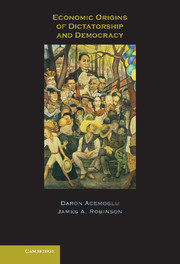Book contents
- Frontmatter
- Contents
- Preface
- PART ONE QUESTIONS AND ANSWERS
- PART TWO MODELING POLITICS
- PART THREE THE CREATION AND CONSOLIDATION OF DEMOCRACY
- PART FOUR PUTTING THE MODELS TO WORK
- PART FIVE CONCLUSIONS AND THE FUTURE OF DEMOCRACY
- PART SIX APPENDIX
- 12 Appendix to Chapter 4: The Distribution of Power in Democracy
- Bibliography
- Index
12 - Appendix to Chapter 4: The Distribution of Power in Democracy
Published online by Cambridge University Press: 05 September 2012
- Frontmatter
- Contents
- Preface
- PART ONE QUESTIONS AND ANSWERS
- PART TWO MODELING POLITICS
- PART THREE THE CREATION AND CONSOLIDATION OF DEMOCRACY
- PART FOUR PUTTING THE MODELS TO WORK
- PART FIVE CONCLUSIONS AND THE FUTURE OF DEMOCRACY
- PART SIX APPENDIX
- 12 Appendix to Chapter 4: The Distribution of Power in Democracy
- Bibliography
- Index
Summary
Introduction
In this appendix, we discuss the models that underpin the analysis of distribution of political power in democracy in the last section of Chapter 4. There we argued that, under some circumstances, the equilibrium policy in democracy could be thought of as maximizing a weighted sum of the indirect utilities of the rich and the poor. We now develop a series of models that can provide microfoundations for those claims and clarify what those “circumstances” are.
Probabilistic Voting Models
Probabilistic Voting and Existence of Equilibrium
Before we discuss the probabilistic voting model, it is useful to revisit the nonexistence of voting equilibria in models without single-peaked preferences. Recall that the MVT applies only when the policy space is single-dimensional and preferences are single-peaked. Although in this book we obtained a lot of mileage from models that satisfy these assumptions, many real-world situations – where there are cross-cutting coalitions and multidimensional differences – do not. In these situations in which the MVT does not apply, the party competition game often does not have an equilibrium in terms of pure strategies. Although in these situations mixed-strategy equilibria exist, it is often unappealing to think of parties mixing over their platforms. The probabilistic voting model first introduced by Lindeck and Weibull (1987) is useful not only as an alternative approach to policy determination but also because it provides a potential way out of the nonexistence problems that arise in the standard model.
Information
- Type
- Chapter
- Information
- Economic Origins of Dictatorship and Democracy , pp. 361 - 380Publisher: Cambridge University PressPrint publication year: 2005
